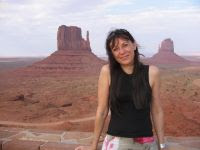 Though I traveled regulary to the Navajo Nation, it is far from my desire to make traditional sand paintings. Some Medicin Men explain : "It takes more than ten years to get to know the language of the Diné perfectly in order to be able to formulate and transmit the know-how of the Ancients".
Though I traveled regulary to the Navajo Nation, it is far from my desire to make traditional sand paintings. Some Medicin Men explain : "It takes more than ten years to get to know the language of the Diné perfectly in order to be able to formulate and transmit the know-how of the Ancients".My inspiration is accepting my ability to go all the way back to the very origins of the meaning, representation and symbolism contained in the function of the sand paintings.
I play the Call game. I live this Otherness with the Other so I can be intensely capable of creating connections with today's Otherness, capable of connecting with that which does not come from me but that Otherness within me.
At certain times when I"m creating, my work is the result of this encounter and turns my artistic act into a contribution to the creating of a world that is more fair, more harmonious and more balanced.
The ceremonies are organized by the members of the Navajo Nation who are themselves inscribed in a highly structured system imbued with very serious traditional principles. Their axes and functions are directed not towards an artistic principle but towards a medicinal principle.
Lorenza Garcia - Navajo France





